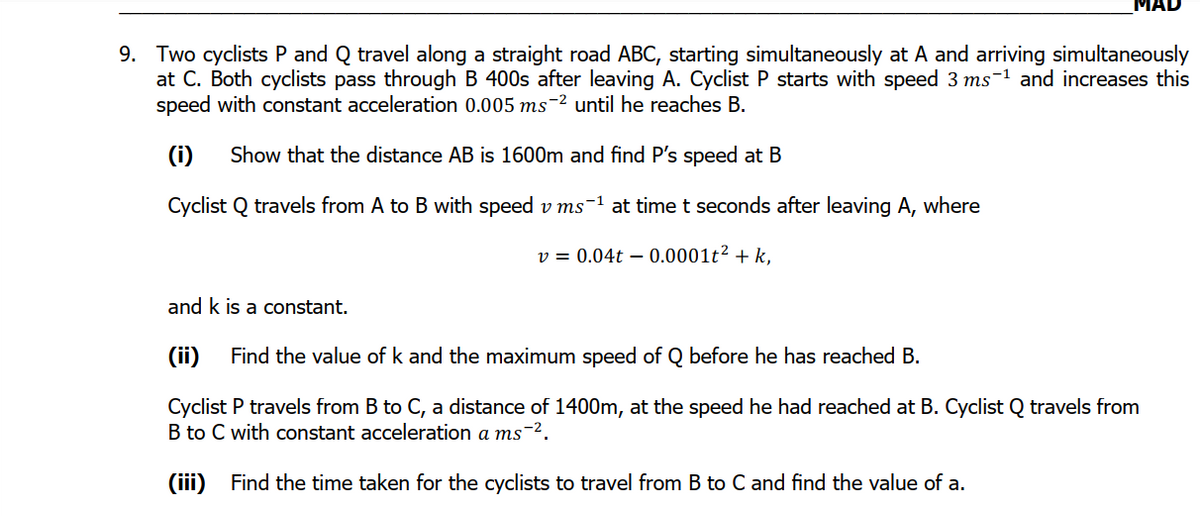Two cyclists P and Q travel along a straight road ABC, starting simultaneously at A and arriving simultaneously at C. Both cyclists pass through B 400s after leaving A. Cyclist P starts with speed 3 ms-1 and increases this speed with constant acceleration 0.005 ms-² until he reaches B. (i) Show that the distance AB is 1600m and find P's speed at B Cyclist Q travels from A to B with speed v ms-1 at time t seconds after leaving A, where v = 0.04t – 0.0001t² + k, and k is a constant. (ii) Find the value of k and the maximum speed of Q before he has reached B. Cyclist P travels from B to C, a distance of 1400m, at the speed he had reached at B. Cyclist Q travels from B to C with constant acceleration a ms-2.
Two cyclists P and Q travel along a straight road ABC, starting simultaneously at A and arriving simultaneously at C. Both cyclists pass through B 400s after leaving A. Cyclist P starts with speed 3 ms-1 and increases this speed with constant acceleration 0.005 ms-² until he reaches B. (i) Show that the distance AB is 1600m and find P's speed at B Cyclist Q travels from A to B with speed v ms-1 at time t seconds after leaving A, where v = 0.04t – 0.0001t² + k, and k is a constant. (ii) Find the value of k and the maximum speed of Q before he has reached B. Cyclist P travels from B to C, a distance of 1400m, at the speed he had reached at B. Cyclist Q travels from B to C with constant acceleration a ms-2.
Functions and Change: A Modeling Approach to College Algebra (MindTap Course List)
6th Edition
ISBN:9781337111348
Author:Bruce Crauder, Benny Evans, Alan Noell
Publisher:Bruce Crauder, Benny Evans, Alan Noell
Chapter2: Graphical And Tabular Analysis
Section2.1: Tables And Trends
Problem 31E
Related questions
Question

Transcribed Image Text:MAD
9. Two cyclists P and Q travel along a straight road ABC, starting simultaneously at A and arriving simultaneously
at C. Both cyclists pass through B 400s after leaving A. Cyclist P starts with speed 3 ms-1 and increases this
speed with constant acceleration 0.005 ms-2 until he reaches B.
(i)
Show that the distance AB is 1600m and find P's speed at B
Cyclist Q travels from A to B with speed v ms-1 at time t seconds after leaving A, where
v = 0.04t – 0.0001t² + k,
and k is a constant.
(ii)
Find the value of k and the maximum speed of Q before he has reached B.
Cyclist P travels from B to C, a distance of 1400m, at the speed he had reached at B. Cyclist Q travels from
B to C with constant acceleration a ms-2.
(iii) Find the time taken for the cyclists to travel from B to C and find the value of a.
Expert Solution
This question has been solved!
Explore an expertly crafted, step-by-step solution for a thorough understanding of key concepts.
This is a popular solution!
Trending now
This is a popular solution!
Step by step
Solved in 3 steps

Knowledge Booster
Learn more about
Need a deep-dive on the concept behind this application? Look no further. Learn more about this topic, calculus and related others by exploring similar questions and additional content below.Recommended textbooks for you

Functions and Change: A Modeling Approach to Coll…
Algebra
ISBN:
9781337111348
Author:
Bruce Crauder, Benny Evans, Alan Noell
Publisher:
Cengage Learning

Algebra & Trigonometry with Analytic Geometry
Algebra
ISBN:
9781133382119
Author:
Swokowski
Publisher:
Cengage

Functions and Change: A Modeling Approach to Coll…
Algebra
ISBN:
9781337111348
Author:
Bruce Crauder, Benny Evans, Alan Noell
Publisher:
Cengage Learning

Algebra & Trigonometry with Analytic Geometry
Algebra
ISBN:
9781133382119
Author:
Swokowski
Publisher:
Cengage